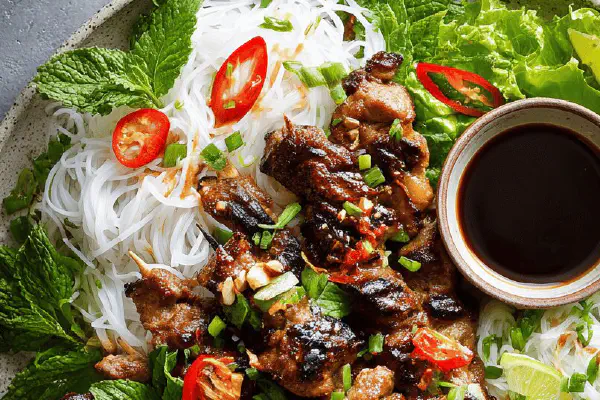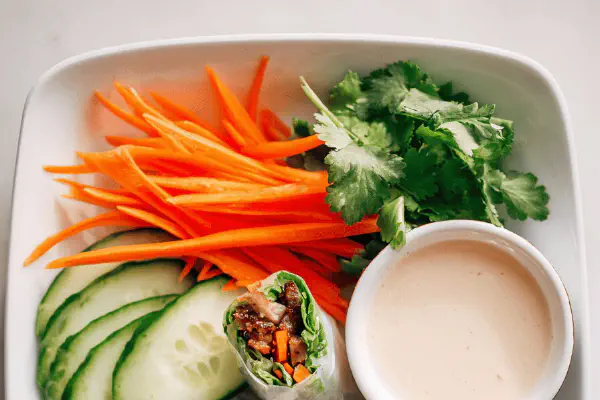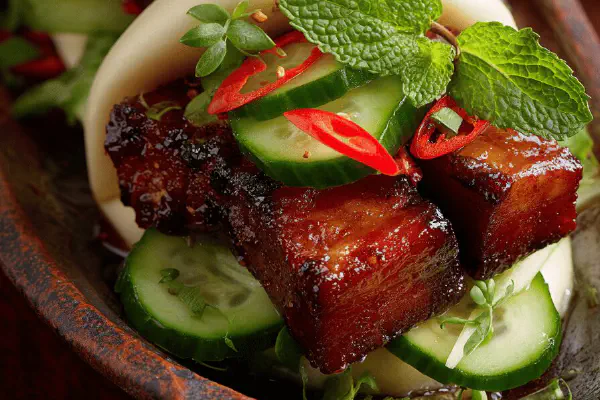Vietnamese Pork Skewers

By Emma
Certified Culinary Professional
Ingredients
- 1 lb pork shoulder, coarsely ground
- 3 garlic cloves, finely chopped
- 1 tbsp rice vinegar
- 1 tsp lime zest, finely grated
- 2 scallions, chopped
- 2 tbsp tamari or soy sauce instead of fish sauce
- Salt and cracked black pepper
- 12 bamboo skewers, soaked in water at least 30 minutes
- about 180 g rice vermicelli noodles, cooked and cooled
- 1 Boston lettuce head, leaves separated
- Fresh mint and cilantro, roughly chopped generously
- Sauce section
- 3 tbsp rice vinegar
- 3 tbsp mushroom soy sauce as substitute for oyster sauce
- 3 tbsp hoisin sauce
- 1/2 cup chicken broth or veggie broth for richness
- Pinch of crushed red pepper flakes
About the ingredients
Method
Skewers
- Heat broiler to high, line baking tray with foil—don’t skip, saves clean-up and encourages even cooking.
- Pulse pork with garlic, vinegar, lime zest, scallion, tamari, salt, pepper in food processor. Texture should be chunky, not paste-like, or risk drying out. Think coarse crumble.
- Divide mixture into 12 portions, shape into 4-inch sausages around soaked skewers. Avoid packing tight: dense makes dry tough bites.
- Arrange on tray, broil mid-rack. After 6–7 minutes, listen for sizzle, edges start caramelizing spotting brown, flip all over gently to cook evenly.
- Total cook 15–17 minutes. Internal color changes—pale pink to opaque white with slight gloss. Probe meat gently to confirm firmness but not rigid.
- Remove, let rest a couple minutes—carryover heat finishes cooking and juices redistribute. No prick holes or dry loss.
Sauce
- Simmer vinegar, mushroom soy, hoisin, broth, chili flakes in small saucepan 5 minutes briskly. Tiny bubbles break surface, sauce thickens slightly, flavors meld.
- Cool to room temp. Layer tasting sauce balance: too salty add water; too sour, splash honey or maple syrup.
To Serve
- Spread lettuce leaves on platter. Each gets a small mound of vermicelli, a skewer, sprinkle herbs.
- Roll tight or loose—texture changes with roll tightness. Dip in sauce, adjust to taste.
- Watch herbs wilt under warmth; add fresh bursts just before eating.
Practical Notes
- Bamboo skewers soak minimum 30 min prevents flames. Substitute metal skewer if broiling directly, but careful—they get hot fast.
- If pork too lean (say sirloin or loin), add a tbsp oil or a spoon of finely grated carrot for moisture; avoid dry, chalky chew.
- Skip garlic if highly sensitive, but flavor will flatten drastically.
- Rice vermicelli stick if overcooked; drain immediately under cold water, toss lightly with touch of oil to separate.
- Adapting herb: Thai basil works for more anise aroma; dill throws it off entirely.
- Hoisin sauce brands vary; some sweeter or saltier. Adjust dipping sauce accordingly; balance—not overpower.
- Broiler timing depends on oven model. Visual and aromatic cues more reliable than clock. Must caramelize edges, sizzle audible. When scent of garlic peaks, check skewers.
Cooking tips
Chef's notes
- 💡 Skewers soak minimum 30 minutes in water. Prevents burning or splintering under broiler heat. If using metal, be ready for fast heat transfer. Handle with tongs, they get hot quick. Bamboo preferred but prep essential.
- 💡 Pork texture crucial; chunky grind better than paste. Use food processor pulses not continuous run. Aim for rough crumble, packs looser around skewer so juices stay put. Avoid dense balls or dry bites, biggest fail in past attempts.
- 💡 Watch color change, feel firmness. Pink fades to opaque white with faint gloss; edges caramelize for aroma cue. No rigid cracking or juice leaks. Use sight and sound. Sizzle, crackle, garlic smell bloom guides timing more than clock.
- 💡 Vermicelli rinsed cold right after cooking. Stops clumping, cools noodles to keep lettuce crisp under warm pork. Toss lightly with oil to separate strands. Otherwise rolls soggy fast—experience speaks here. Fresh herbs layered last, herb heat kills freshness.
- 💡 Sauce balance needs tasting. Mushroom soy replaces oyster sauce for earthiness without fishiness. Adjust vinegar or sweetener to tame sourness or saltiness. Sauce thickens lightly with simmering. Too thick or thin affects dip texture, check tiny bubbles as signal.
Common questions
Can I substitute pork shoulder with leaner cuts?
You can but add extra fat or grated carrot for moisture or use oil. Lean meat dries out quick. Dense meat affects chew, loses juiciness. Works if balanced right but tricky without fat.
What if skewers burn under broiler?
Soak bamboo longer, 30+ mins helps. Or switch to metal skewers but watch hands—hot fast. Arrange skewers center rack, avoid bottom too close to element. Monitor often, char is flavor not fire.
How do I know when pork is done inside?
Sight rules here. Color shifts to opaque white, edges brown. Finger press; firm but bouncy, not rigid. Use smell too, garlic aroma peaks before overcook. Internal temp helps if you prefer, 160°F safe target.
What about storage and leftovers?
Keep pork and vermicelli separate if possible. Wrap airtight, store cool fridge. Sauce holds well and can dilute if thickened. Reheat pork gently to keep moisture, avoid microwave drying. Rolls best fresh but workable next-day.



